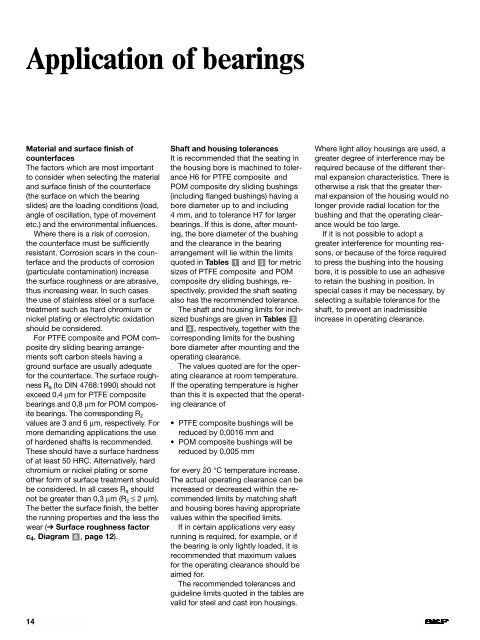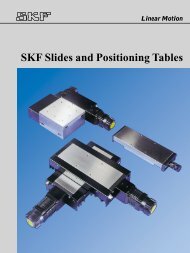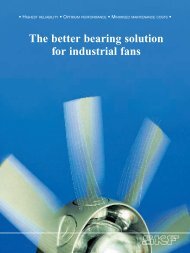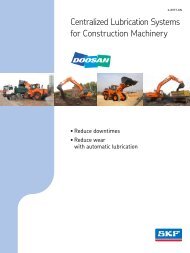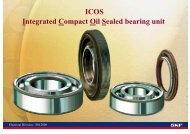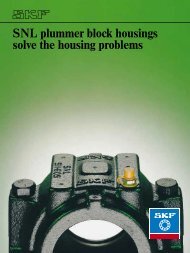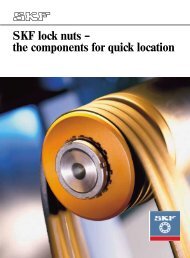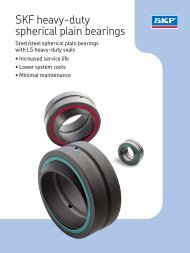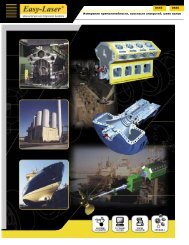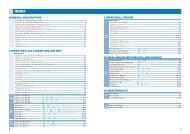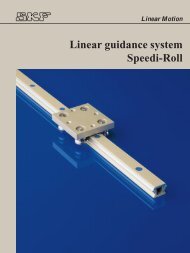Composite dry sliding bearings â maintenance-free and space-saving
Composite dry sliding bearings â maintenance-free and space-saving
Composite dry sliding bearings â maintenance-free and space-saving
You also want an ePaper? Increase the reach of your titles
YUMPU automatically turns print PDFs into web optimized ePapers that Google loves.
Application of <strong>bearings</strong>Material <strong>and</strong> surface finish ofcounterfacesThe factors which are most importantto consider when selecting the material<strong>and</strong> surface finish of the counterface(the surface on which the <strong>bearings</strong>lides) are the loading conditions (load,angle of oscillation, type of movementetc.) <strong>and</strong> the environmental influences.Where there is a risk of corrosion,the counterface must be sufficientlyresistant. Corrosion scars in the counterface<strong>and</strong> the products of corrosion(particulate contamination) increasethe surface roughness or are abrasive,thus increasing wear. In such casesthe use of stainless steel or a surfacetreatment such as hard chromium ornickel plating or electrolytic oxidationshould be considered.For PTFE composite <strong>and</strong> POM composite<strong>dry</strong> <strong>sliding</strong> bearing arrangementssoft carbon steels having aground surface are usually adequatefor the counterface. The surface roughnessR a (to DIN 4768:1990) should notexceed 0,4 µm for PTFE composite<strong>bearings</strong> <strong>and</strong> 0,8 µm for POM composite<strong>bearings</strong>. The corresponding R zvalues are 3 <strong>and</strong> 6 µm, respectively. Formore dem<strong>and</strong>ing applications the useof hardened shafts is recommended.These should have a surface hardnessof at least 50 HRC. Alternatively, hardchromium or nickel plating or someother form of surface treatment shouldbe considered. In all cases R a shouldnot be greater than 0,3 µm (R z ≤ 2 µm).The better the surface finish, the betterthe running properties <strong>and</strong> the less thewear (➔ Surface roughness factorc 4 , Diagram 6 , page 12).14Shaft <strong>and</strong> housing tolerancesIt is recommended that the seating inthe housing bore is machined to toleranceH6 for PTFE composite <strong>and</strong>POM composite <strong>dry</strong> <strong>sliding</strong> bushings(including flanged bushings) having abore diameter up to <strong>and</strong> including4 mm, <strong>and</strong> to tolerance H7 for larger<strong>bearings</strong>. If this is done, after mounting,the bore diameter of the bushing<strong>and</strong> the clearance in the bearingarrangement will lie within the limitsquoted in Tables 1 <strong>and</strong> 3 for metricsizes of PTFE composite <strong>and</strong> POMcomposite <strong>dry</strong> <strong>sliding</strong> bushings, respectively,provided the shaft seatingalso has the recommended tolerance.The shaft <strong>and</strong> housing limits for inchsizedbushings are given in Tables 2<strong>and</strong> 4 , respectively, together with thecorresponding limits for the bushingbore diameter after mounting <strong>and</strong> theoperating clearance.The values quoted are for the operatingclearance at room temperature.If the operating temperature is higherthan this it is expected that the operatingclearance of• PTFE composite bushings will bereduced by 0,0016 mm <strong>and</strong>• POM composite bushings will bereduced by 0,005 mmfor every 20 °C temperature increase.The actual operating clearance can beincreased or decreased within the recommendedlimits by matching shaft<strong>and</strong> housing bores having appropriatevalues within the specified limits.If in certain applications very easyrunning is required, for example, or ifthe bearing is only lightly loaded, it isrecommended that maximum valuesfor the operating clearance should beaimed for.The recommended tolerances <strong>and</strong>guideline limits quoted in the tables arevalid for steel <strong>and</strong> cast iron housings.Where light alloy housings are used, agreater degree of interference may berequired because of the different thermalexpansion characteristics. There isotherwise a risk that the greater thermalexpansion of the housing would nolonger provide radial location for thebushing <strong>and</strong> that the operating clearancewould be too large.If it is not possible to adopt agreater interference for mounting reasons,or because of the force requiredto press the bushing into the housingbore, it is possible to use an adhesiveto retain the bushing in position. Inspecial cases it may be necessary, byselecting a suitable tolerance for theshaft, to prevent an inadmissibleincrease in operating clearance.


